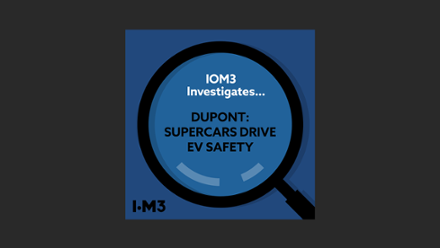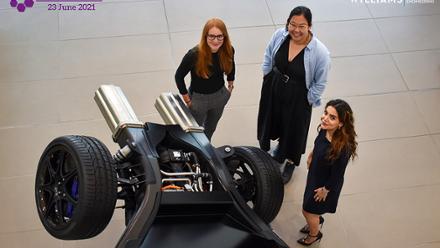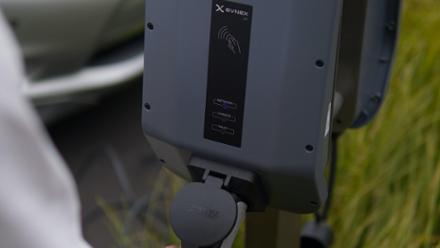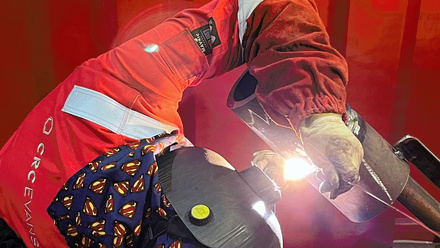Gigaplants, gumption and batteries - a profile of Isobel Sheldon
Battery industry expert Isobel Sheldon has been brought in as Chief Strategy Officer at Britishvolt to support building of the UK’s first large-scale cell gigaplant.
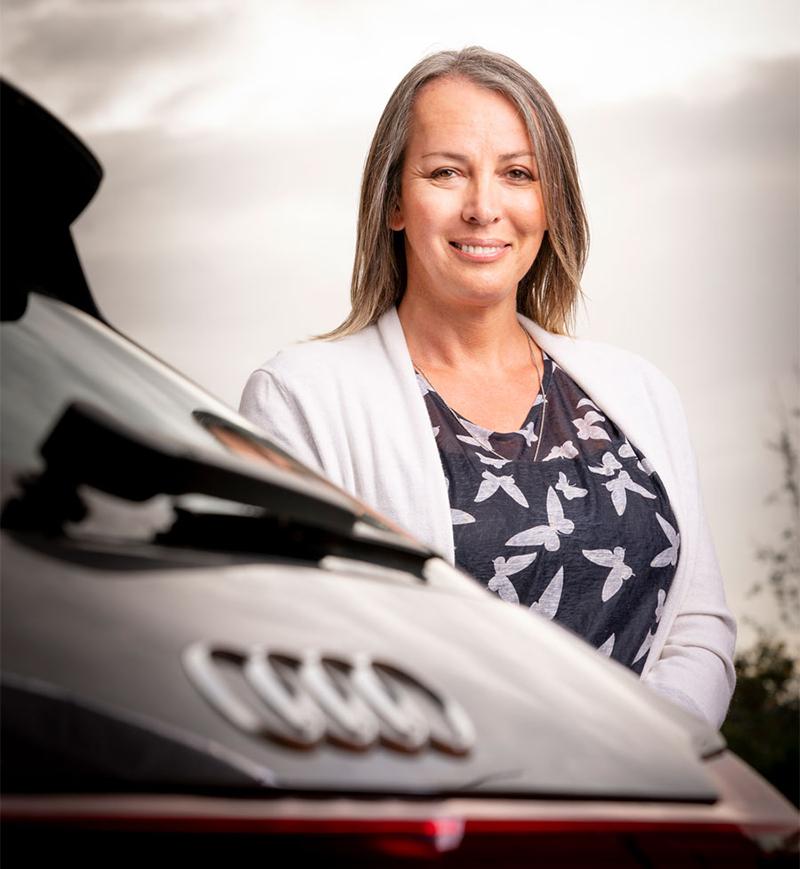
As the acceptance sound on our Teams call signals the start of our video chat, Isobel Sheldon greets me with the brightest smile and a wave. Behind her, on the wall, is a decal sticker that reads, ‘Eat glitter for breakfast and sparkle all day’. A sign that will later shine more light on Isobel and how she has become a pioneer in the battery industry.
But batteries were not always on her radar growing up. With her father in the Royal Air Force, she wanted to be a fighter pilot. She tells me that living on air bases turned her into an ‘aircraft nut’. And then one day, when she was seven, she found her father repairing their family car. Nothing was ever quite the same again.
‘He had an old Ford Cortina Mark III back in the early-70s. The Ford Cortinas were very different cars to what we have on the road today. It’s quite a common car to repair yourself,’ she recalls. While her father finished up the repairs, young Isobel stood at the back-end of the car and can still remember clear as day what happened.
‘I saw the exhaust gases coming out of the exhaust pipe. And so, I asked, “Is that what pushes the car along? The smoke coming out of the exhaust pipe?”’
Her father then proceeded to explain that, actually, that is not how it works. And so began a long monologue ‘about pistons, sparkplugs, the four-stroke cycle of a four-stroke engine and how that turns the crankshaft, then the gearbox and the propshaft to a differential which then, in turn, makes the wheels turn’.
However, what Isobel wanted to know was what made the explosion happen. When she was told that what makes the pistons operate is fuel, air and the spark from the sparkplug, Isobel thoughtfully noted to her father that we consume air, he said 'yes', and out the back comes water, carbon dioxide and nitrogen dioxide, and all these components.
Although a slightly naïve thinking pattern for a seven-year-old, Isobel remembers that she firmly believed we would consume all the air in car engines if we didn’t find an alternative.
‘Although it does consume oxygen, we're not really likely to run out. What I was missing was all the pollutants that come out in the CO2, NOx and the particulates and stuff. But I wasn't aware of those at the time. And I remember thinking at that very young age, that there had to be a better way than burning fuel and consuming oxygen.
‘So right in my early childhood, when I was able to start to understand these concepts, I was pretty much looking for an alternative way of moving around, that's where the idea was born.’
Plan B becomes plan A
She says that everything else in her life has been something of a plan B. Isobel skipped university and, since then, has not longed for a university degree. She started her career at Marconi as an Electronics Technician processing devices, where she gained some electrochemical knowledge, before spending time learning about fabrication engineering for various engineering firms and, ultimately, finding her way back to her quest to reduce a car’s air consumption. She entered the automotive industry as Programme Manager at L&L Products in Strasbourg, France.
Her next career move was one that required gumption and, in retrospect, Isobel reflects that starting her own company at the age of 33 was, ‘quite the leap’. 13 May 2003, she recalls, was the day she started Amberjac Projects Ltd, so she could ‘do things differently’. She shares how she started her company to develop battery systems, and to hopefully gain more freedom as she searched for ‘something that I could hang my hat on. I needed something that said, "this is different, this is new"'.
It was important to take every opportunity to self-educate and listen to experts within the field. She continues, ‘I raised some money off some high net-worth individuals, some early seed capital, then went and bought a Toyota Prius to work with. I worked with a partner company called Energy CS and the team over in California and, between us, we put on the road the first lithium-ion-powered plug-in hybrids in the world. I was in fact the first person in the world to commercially sell them. We had about 45 that we sold out to early adopters and companies doing research. And it sort of grew from there. And really for the first time in my life, I found myself on equal terms with everybody else, because nobody else knew what they were doing either. So, it's a level playing field.’
The driving force
Isobel is driven by a belief that there is a better route forward. She asserts, we can ‘make electric vehicles interesting. We can do things that make people think “that's a great car, not that's an electric car”. So, some of the vehicle programmes, or some of the original equipment manufacturers (OEMs), I've been involved in at various stages allowed me to participate in programmes that have created some pretty amazing pieces of machinery.
‘And I firmly believe that getting products out into the marketplace that customers really want to buy and have an ambition to own is going to be a really important part of this market moving forwards. That's where my passion comes from, I want to make these interesting products. I want to make these nice vehicles to drive with high performance levels and be enjoyable to own. If we can turn the buying public, by improving the desirability, then I think we're onto a really good thing,’ she enthuses.
Giga what?
Pressing the accelerator forward, we arrive at today where Isobel tells me that her day-to-day as the new Chief Strategy Officer of Britishvolt is now mainly spent, like the rest of us, at home and in front of her computer. Although COVID-19 is making some activities a challenge, she explains she is currently looking at supply chain partners, developing manufacturing strategies, technology roadmaps, as well as trying to decide what the future of Britishvolt is going to look like from a manufacturing technology perspective – peanuts in other words.
‘So, I'm spreading myself quite thin at the moment,' she says laughing, 'and I'm enjoying every minute of it. You know, the devil plays games with idle thumbs, so it's keeping me out of mischief, that's for sure.’
She says as the team grows she will hand-over some of these responsibilities. ‘I knew [the Britishvolt role] would stretch me, it would stretch my skills and my capabilities. They will utilise all of the skill silos that I have. And that's what I'm finding...which is what I needed. I'm able to catalyse a lot of the skill sets that I've built over the years now, not just in technology and making and designing stuff, but also on the business side and making sure that from the business perspective we will be positioned for growth.
‘And that really is making me very happy on a daily basis. I get to the end of the day, and I think I've done an amazing amount of work. I can’t believe how much I’ve achieved. At the end of the week, it is like, “where did the week go?” But it gives me an enormous amount of satisfaction.'
It strikes me that her passion and her belief in the work she is doing will be tremendously important for the project Britishvolt is currently embarking on – the UK’s first large-scale cell gigaplant. There are a lot of eyes nationwide awaiting the success of this ambitious plan.
The gigaplant will measure 500x500m. When Isobel says that it will take a whole 15 seconds to drive past it, while travelling at 100km/h, my eyes widen. She responds with a big smile and a nod as she sees that the scale of the plant is starting to sink in.
She enthusiastically explains that the gigaplant is needed in the UK primarily because there isn’t one yet, and that with the UK market being fairly different to China, Korea and even Central Europe, with high-end brands like Bentley and Rolls-Royce, they will require something else than ‘run-of-the-mill cell technology’.
Isobel adds, ‘The Faraday Institution is valuing the UK market at about 120GWh by mid-2030. We are putting in place 30GWh, so we are going to satisfy a quarter of the demand – there is room for more suppliers in the UK market.’
The building process will be in three phases she explains, with each supplying 10GWh. The first should be in place by 2023, the next in 2025, and the final phase by 2027.
Isobel says, ‘The first 10GWh will be state-of-the-art, if not better than what the current cell market can provide. It gives OEMs the opportunity to uplift their performance levels and start to compete with the likes of Tesla effectively. The second 10GWh in 2025 will be those close-to-market technologies that aren't quite ready for the commercialisation stage, but will be in a couple of years’ time. And because we're agile and flexible in our approach, we will be able to adopt those technologies much more easily than the way the other big factories or bigger plants are all configured around the world.
‘And then for the third 10GWh, we're not making a firm decision. So we're waiting to see what technology comes along in 2025 and 2026, then start looking at commercialising that, so it could be solid-state.
Solid-state has problems, it's not all solved at the moment, you can’t hang your hat on it. But maybe in the next two or three years, some of those problems may be solved. And if they are, we want to be able to capitalise on that advanced development and carry those forward into production.’
She notes, ‘To do this, we need to put up a big building, and it's going to be the fourth largest building in the UK and the 16th largest building in the world. If you take the footprint of the Vatican City, including all the waterways, it's about 60% the size of the Vatican City in land area. So we're talking about a significant building. And yes, that is a scary thought. It's going to require an awful lot of planning, expertise and skills, which we already have on board.’
So a minor project in all, I joke. She laughs as she promises delivery for the last Tuesday of the month.
Dedicated to diversity
For someone who works this much, what does she do to log off? She jokes there is no such thing as logging off when you’re working for a start-up, but that she has a growing interest in cooking, although she admits she’s not especially good at it. In a bid to expand her repertoire, she recently cooked a brisket for ten hours for her partner Jacqui’s birthday.
Touching on her home life, I remember an article I found about how she was nominated in 2017 for the LGBT+ Diversity Champions by the British LGBT Awards. This was in recognition of an LGBT+ Network she helped set up at Johnson Matthey Battery Systems.
Isobel recalls that it came about after a conversation with a colleague that was on the LGBT+ spectrum and was apprehensive about whether to be open about it at work. They went and got sponsorship from the Board and made the first steps in setting up the framework. She is very clear that she was only there in the early stages. But that the torch was taken on by others who ran with it.
Her focus remains on building diverse teams.
‘I remember looking at my 45-member engineering team at Johnson Matthey that I built from eight people. And we had everybody on the L spectrum, the G spectrum, the B spectrum and the T spectrum, and staff with disabilities. We hosted all the faiths there, the different races, we had people from all age categories. We've had disability or be it invisible disability at the time. And all the protected characteristics were represented in the team that I had. And I felt incredibly proud.’
As we come to the end of our chat, I ask Isobel who she calls when she needs to air her thoughts, and she tells me that it used to be her mother, who now has dementia. But now, ‘I will always seek the opinion of my children because I value their thoughts. My daughter's a paramedic in the National Health Service and my son's an engineering apprentice at Rolls-Royce. They are level-headed so I seek their advice. And along with Jacqui, I think we always come to reasonable conclusions’.
As I press the leave button on our Teams call, I quietly reflect on the sign in the background of our interview, ‘Eat glitter for breakfast and sparkle all day’.
‘I think it's really important to understand there is no one battery that does everything, different application requirements need different solutions.
‘There's so much money that's going to be invested into lithium-ion technology and manufacturing it with the coating processes, that we are going to have a lithium-ion dominant landscape for the next ten to 13 years. You have to make technology decisions today because the CO2 targets become impossible to meet otherwise.
'You've also got things like lithium iron phosphate. This material has been around for more than 20 years. It's very stable, it has a very long life, it can do power pretty well. And it's been used in things like high-power applications for hybrid and plug-in hybrids. But it could also provide a lower-energy density, a lower-cost solution for lower-range electric vehicles that don't need that ultimate capacity. So, I think for the bell curve, where the majority of people are going to spend their money, I think that lithium iron phosphate offers a solution.
'And the same thing can be true of sodium ion. I don't think it's ever going to compete with nickel’s energy density. But for that medium sector, that medium-energy density, or the power piece, I think that sodium ion has got some advantages. And certainly, being able to discharge it to zero volts and then just cycling upwards, that's significant. You don't have to worry about breaking batteries, which happens with electric vehicles if you leave them idle for too long.
'Sodium ion is really interesting because it is pretty much a drop-in replacement for lithium ion technology. So, it can be made on the same equipment. I don't think you would want to run one after the other without a significant clean down, but it does have some interesting possibilities that there might be another chemistry that can be easily adopted into existing manufacturing processes.
'And we are going see a lot of this over the next ten years – drop-in replacements for some of the materials that we've got, using the same processing technology, is an incremental way to grade improvements, either in cost, energy, power or cycle life.
'I think the automotive industry is now starting to understand that we've got this dichotomy between energy and cycle life. So the higher the energy, the lower the cycle life. Typically, you can start to trade-off the cycle life improvements with energy.’
Isobel on the battery industry
‘I think it's really important to understand there is no one battery that does everything, different application requirements need different solutions.
‘There's so much money that's going to be invested into lithium-ion technology and manufacturing it with the coating processes, that we are going to have a lithium-ion dominant landscape for the next ten to 13 years. You have to make technology decisions today because the CO2 targets become impossible to meet otherwise.
'You've also got things like lithium iron phosphate. This material has been around for more than 20 years. It's very stable, it has a very long life, it can do power pretty well. And it's been used in things like high-power applications for hybrid and plug-in hybrids. But it could also provide a lower-energy density, a lower-cost solution for lower-range electric vehicles that don't need that ultimate capacity. So, I think for the bell curve, where the majority of people are going to spend their money, I think that lithium iron phosphate offers a solution.
'And the same thing can be true of sodium ion. I don't think it's ever going to compete with nickel’s energy density. But for that medium sector, that medium-energy density, or the power piece, I think that sodium ion has got some advantages. And certainly, being able to discharge it to zero volts and then just cycling upwards, that's significant. You don't have to worry about breaking batteries, which happens with electric vehicles if you leave them idle for too long.
'Sodium ion is really interesting because it is pretty much a drop-in replacement for lithium ion technology. So, it can be made on the same equipment. I don't think you would want to run one after the other without a significant clean down, but it does have some interesting possibilities that there might be another chemistry that can be easily adopted into existing manufacturing processes.
'And we are going see a lot of this over the next ten years – drop-in replacements for some of the materials that we've got, using the same processing technology, is an incremental way to grade improvements, either in cost, energy, power or cycle life.
'I think the automotive industry is now starting to understand that we've got this dichotomy between energy and cycle life. So the higher the energy, the lower the cycle life. Typically, you can start to trade-off the cycle life improvements with energy.’
Isobel on battery recycling
'Recycling will be an important part of the electric vehicle future. There are a number of processes that are used today, none of them ideal, and novel development programmes are looking into more efficient and less environmentally harmful processes.
'The amount of recycled material used in the lithium-ion battery industry will depend on the quantity of feedstock coming in from first or second life applications (electric vehicle and stationary energy storage), which is fairly low and doesn’t represent an immediate business case for large-scale dedicated recycling facilities. But as volumes grow and business cases firm up for the large-scale deployment of capital, the time that the industry needs to refine processes means that we will be in a good place to effectively recycle larger volumes of electric vehicle batteries once those batteries start to return from market in higher volumes.'


